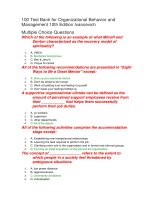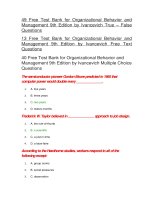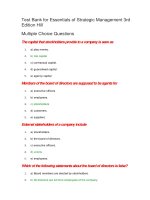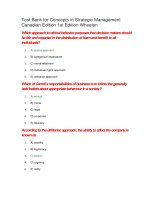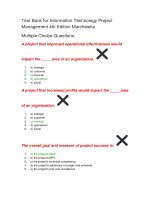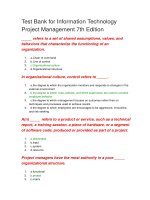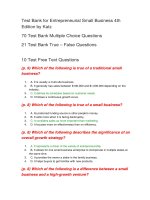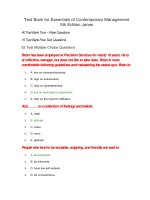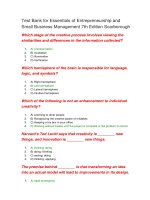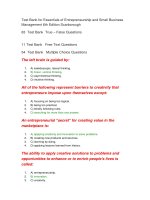130 test bank for effective small business management 10th edition scarborough
Bạn đang xem bản rút gọn của tài liệu. Xem và tải ngay bản đầy đủ của tài liệu tại đây (151.21 KB, 28 trang )
Test Bank for Effective Small Business Management
10th Edition Scarborough
A competitive profile matrix:
1.
2.
3.
4.
A) identifies a firm's core competencies.
B) permits the small business owner to divide a mass market into smaller, more
manageable segments.
C) compares the firm's and its competitors' key success factors.
D) creates a road map of action for the entrepreneur in order to fulfill his/her
company's mission, goals, and objectives.
________ are positive internal factors that contribute towards
accomplishing the company's objectives.
1.
A) Strengths
2.
B) Weaknesses
3.
C) Opportunities
4.
D) Threats
A small firm's ability to identify and manipulate the ________ in its
business determines its ability to compete effectively.
1.
A) key success factors
2.
B) corporate vision and mission
3.
C) opportunities and threats
4.
D) market environment
The strategic planning process for small businesses is:
1.
A) market-focused.
2.
B) the same as it is for a large company.
3.
C) generally done by top management with little or no participation by employees.
4.
D) product-focused and similar to that for large companies.
________ are negative external forces that inhibit the firm's ability to
achieve its objectives.
1.
A) Strengths
2.
B) Weaknesses
3.
C) Opportunities
4.
D) Threats
Corey notices a "backlash" against health food among people who eat
out. He decides to open a restaurant that stresses "good home cooking,"
heavy with gravies, breads, oils, etc. Corey has identified and is trying to
capitalize on a(n) ________ in the market environment.
1.
A) strength
2.
B) weakness
3.
C) threat
4.
D) opportunity
The primary output of the strategic management process should be:
1.
A) a matching of its strengths and weaknesses to the opportunities and threats in
the environment.
2.
B) an enticement to outside investors and lenders to put money into the business.
3.
C) a complete explanation of the company's product or service.
4.
D) a description of the company's competitive situation.
When the small business owner assesses her company's strengths and
weaknesses, she is dealing with the ________ business environment.
1.
A) macro
2.
B) external
3.
C) competitive
4.
D) internal
Joan is seeking to answer a series of questions such as: How do
competitor's cost structures compare to ours, what new competitors are
entering the industry, what do our customers say about competitors, etc.
By asking these questions, Joan is:
1.
A) conducting a SWOT analysis.
2.
B) identifying her company's key success factors.
3.
C) formulating strategic options for her company.
4.
D) performing a competitive analysis.
Which of the following is true about successful entrepreneurs and their
vision?
1.
A) It is created independently of their market or their customers.
2.
B) It includes their understanding of the competition and their key market
segments.
3.
C) They are able to communicate it and their enthusiasm for it to all those around
them.
4.
D) They create it in cooperation with their employees.
________ are negative internal factors that inhibit the accomplishment of a
firm's objectives.
1.
A) Strengths
2.
B) Weaknesses
3.
C) Opportunities
4.
D) Threats
A mission statement should answer which of the following questions?
1.
A) What are the needs and wants of the target customers?
2.
B) How will we finance our growth and expansion?
3.
C) Who are our competitors?
4.
D) How much money will we make?
Purchasing rival companies' products, taking them apart, and analyzing
them is:
1.
A) industrial espionage.
2.
B) illegal due to federal regulation.
3.
C) benchmarking.
4.
D) cataloguing.
________ are relationships between a controllable variable–plant size,
quality, packaging–and a critical factor influencing the firm's ability to
compete in the marketplace.
1.
A) Core competencies
2.
B) The competitive advantages
3.
C) Key success factors
4.
D) Goals and objectives
These are products of the interaction of various forces, trends, and events
that are outside the control of the small business.
1.
A) distinctive competencies
2.
B) key success factors
3.
C) opportunities and threats
4.
D) strengths and weaknesses
Answering the question "What business am I in?" defines the company's:
1.
A) mission.
2.
B) assessment of its own strengths and weaknesses.
3.
C) external opportunities and threats.
4.
D) goals and objectives.
Every business is characterized by a set of controllable variables called
________ that determines the relative success (or lack of it) of market
participants:
1.
A) distinctive competencies
2.
B) key success factors
3.
C) opportunities and threats
4.
D) competitive edge
________ are the broad, long-range attributes the small business seeks to
accomplish; ________ are the specific, measurable milestones the
company wants to achieve.
1.
A) Goals; objectives
2.
B) Goals; strategies
3.
C) Objectives; goals
4.
D) Strategies; goals
How is the strategic planning process for small companies different from
that for large companies?
1.
A) The planning horizon should cover at least five years into the future.
2.
B) The process should begin with setting objectives and conclude with competitive
analysis.
3.
C) The process should be informal and not overly structured–"a shirtsleeve
approach."
4.
D) It should be conducted by top management and provided to lower
management.
The information-gathering process in competitive analysis:
1.
A) is an expensive process that only established small companies can afford.
2.
B) can be relatively inexpensive and easy for the small business owner to conduct.
3.
C) is closely regulated by various federal laws.
4.
D) is a process that requires expert help but is relatively inexpensive.
A small business's "aggregation of factors that sets it apart from its
competitors" is its:
1.
A) strategic plan.
2.
B) competitive advantage.
3.
C) vision.
4.
D) competitive strategy.
A small business owner would conduct a competitive analysis in order to:
1.
2.
A) influence customers' perceptions of the company and products' image.
B) avoid surprises from existing competitors and to identify potential new
competitors.
3.
C) divide the market into smaller, homogeneous units.
4.
D) scan the environment for weaknesses and strengths on which to capitalize.
The strategic management process:
1.
A) is especially difficult for the small business because of its limited resources.
2.
B) divides mass markets into smaller, less homogeneous units.
3.
C) provides the small business owner with the tools for managing the
uncontrollable elements in the external business environment.
4.
D) helps a small business develop the game plan that guides it in creating its
mission, vision, goals, and objectives.
Which of the following best expresses the relationship of a company
vision to its mission?
1.
A) The company vision comes from the company mission.
2.
B) The mission statement is the written expression of the company vision.
3.
C) The company mission statement is the verbal expression of the written vision.
4.
D) There is no relationship between the two.
Once the vision and mission are established, the entrepreneur needs to:
1.
A) select the target market.
2.
B) conduct market research.
3.
C) choose a competitive strategy.
4.
D) assess the firm's strengths and weaknesses.
________ focuses everyone's attention and efforts on the same target
market. It is an expression of what the owner believes in.
1.
A) The mission statement
2.
B) The company vision
3.
C) The strategic plan
4.
D) The operational plan
59 Free Test Bank for Effective Small Business
Management 10th Edition Scarborough Multiple
Choice Questions - Page 2
A ________ strategy tends to be ideally suited to the small business.
1.
A) differentiation
2.
B) focus
3.
C) cost leadership
4.
D) product quality
To be effective, these competencies should be ________ for competitors
to duplicate, and they must provide customers with a valuable perceived
benefit.
1.
A) easy
2.
B) moderate
3.
C) difficult
4.
D) None of the above
The focal point of a firm's strategy is:
1.
A) the firm's goals and objectives.
2.
B) the firm's key success factors.
3.
C) the customer.
4.
D) the firm's strengths and weaknesses.
Small bookstores have a giant killer of a competitive advantage in their:
1.
A) lower costs.
2.
B) better locations.
3.
C) customer service.
4.
D) large selection.
In the creation of the balanced scorecard, the entrepreneur needs to:
1.
2.
3.
4.
A) assess competitor's strengths and weaknesses and set measures against
them.
B) establish goals for each critical factor of company performance.
C) think about the resource requirements necessary to implement the action
plans.
D) do all of these.
Small businesses have a natural advantage over large competitors when it
comes to developing a strategy for competitive advantage because small
businesses have all these except:
1.
A) fewer product lines.
2.
B) better-defined customer base.
3.
C) access to more capital.
4.
D) specific geographic market area.
The final step of the strategic planning process is:
1.
A) establishing accurate controls.
2.
B) translating the strategic plan into operational plans.
3.
C) evaluating the competitive environment.
4.
D) choosing a marketing strategy to pursue.
When translating strategic plans into action plans, the small business
owner should:
1.
2.
A) not delegate authority or responsibility at this point.
B) not assign priorities to the action plans, but manage the process from the
conceptual level.
3.
C) not adjust or change the plan but commit to implementing as it stands.
4.
D) remember that no strategic plan is complete until it's put into action.
Rather than attempting to serve the total market, the small firm pursuing a
________ strategy specializes in serving a specific target segment.
1.
A) cost leadership
2.
B) differentiation
3.
C) focus
4.
D) head-to-head
Which strategy recognizes that not all markets are homogenous?
1.
A) Focus
2.
B) Differentiation
3.
C) Cost Leadership
4.
D) Price sensitive
Tyson Foods' practice of adding value to its chicken products by
deboning, skinning, bite-sizing, or pre-cooking them is an example of a:
1.
A) cost leadership strategy.
2.
B) differentiation strategy.
3.
C) focus strategy.
4.
D) concentration strategy.
The principle behind a ________ strategy is to select one or more market
segments, identify customers' special needs, and approach them with a
good or service designed to excel in meeting these needs.
1.
A) cost-leadership
2.
B) differentiation
3.
C) focus
4.
D) concentration
________ are specific measurable targets to be accomplished in a defined
time period.
1.
A) Core competencies
2.
B) Objectives
3.
C) Goals
4.
D) Key success factors
The strategic management procedure for a small business should include
the following features:
1.
A) Use a relatively short planning horizon easy
2.
B) Encourage the participation of employees moderate
3.
C) Be informal and not overly structured difficult
4.
D) All of the above
A small company following a ________ strategy seeks to build customer
loyalty by positioning its goods and services in a unique fashion.
1.
A) differentiation
2.
B) cost leadership
3.
C) focus
4.
D) niche
Which of the following is a danger in choosing a differentiation strategy?
1.
A) Charging a price so high that the company prices itself out of the market
2.
B) Choosing a basis for price leadership that is essentially unimportant to the
customer
3.
C) Choosing a market that is not large enough to be profitable
4.
D) An overfocus on overhead costs
Cost leadership has several inherent dangers such as:
1.
A) choosing to distinguish the product that does not boost its performance.
2.
B) an overfocus on the physical characteristics of the product.
3.
C) the identified niche is not large enough to be profitable.
4.
D) an overfocus on costs to the elimination of other strategies.
An effective strategic plan does which of the following?
1.
A) Identifies a complete set of success factors–financial, operating, and marketing,
that yield a competitive advantage for the company
2.
B) Focuses on one generic strategy to the exclusion of all other strategies
3.
C) Always seeks a high profile in the specific markets chosen
4.
D) Is always cost based
________ is not a primary goal of a competitive intelligence program
1.
A) Avoiding surprises from existing competitors' new strategies and tactics
2.
B) Identifying potential new competitors
3.
C) Improving reaction time to competitors' actions
4.
D) All these are primary goals of a competitive intelligence program.
A strategic plan should not:
1.
A) be relatively small.
2.
B) begin with extensive objective setting.
3.
C) encourage participation by employees.
4.
D) be informal and not structured.
________ are a unique set of capabilities that a company develops in key
areas, such as superior quality, customer service, innovation, teambuilding, flexibility, speed, responsiveness, and others that allow it to
vault past competitors.
1.
A) Core Competencies
2.
B) Focus strategy
3.
C) Cost leadership strategy
4.
D) None of the above
A company may have a powerful competitive advantage, but it is wasted
unless:
1.
A) the owner has communicated that advantage to workers.
2.
B) the customers are recommending the company to their friends.
3.
4.
C) the workers communicate who, in turn, work hard to communicate it to
customers and potential customers.
D) All of the above
Competitive advantage is:
1.
A) to be easily duplicated by competitors.
2.
B) to have a super idea.
3.
4.
C) the aggregation of factors that sets the small business apart from its
competitors and gives it a unique position in the market.
D) None of the above
Intellectual capital of a company is comprised of which components?
1.
A) Talent and skills of its workforce
2.
B) Software, patents, copyrights
3.
C) Experience of the people in the company
4.
D) Customer base, reputation and goodwill
A differentiation strategy:
1.
A) seeks to find and defend an identifiable market niche.
2.
B) is built on a company's distinctive competence.
3.
C) must create the perception of value in the customer's eyes through the lowest
possible price.
4.
D) focuses solely on making the physical characteristics of the product as unique
as possible.
The most successful strategic plans make the ________ focal.
1.
A) competitive analysis
2.
B) customer
3.
C) product
4.
D) control process
The small firm's "master plan" is its:
1.
A) objectives.
2.
B) goals.
3.
C) competitive edge.
4.
D) strategy.
Strategic management is a process that involves:
1.
A) developing a vendor list.
2.
B) developing a vision and mission statement.
3.
C) developing goals and objectives.
4.
D) Both B and C
The ________ is a set of measures unique to the company that gives
managers a quick and comprehensive view of how the business is doing
and includes both financial and operational factors.
1.
A) core competencies
2.
B) key success factors
3.
C) balanced scorecard
4.
D) action plan
Small firms pursuing a cost leadership strategy have an advantage in
reaching customers whose primary purchase criterion is:
1.
A) quality.
2.
B) constant innovation.
3.
C) price.
4.
D) customer service.
It is important for the small business owner to remember that the strategic
planning process is:
1.
A) an ongoing process that must be repeated.
2.
B) a top management process completed only once every two years.
3.
C) a process which involves all the employees once every five years.
4.
D) one that should produce a detailed, elaborate plan for running the business
over the next 3—5 years.
A small business owner needs to remember that when it comes to
employee involvement in the strategic planning process:
1.
A) involvement is a prerequisite for the achievement of total employee
commitment.
2.
B) his/her employees look to him/her for leadership and do not want to be
involved.
3.
4.
C) the delegation of authority is not as important as communicating a clear vision.
D) employees do not need to be involved in the strategic process but do need to
be involved in the operational process.
The final step in creating a knowledge management program is:
1.
A) to organize the essential knowledge and disseminate it throughout the
company to those who need it.
2.
B) to take an inventory of the special knowledge a company possesses that gives
it a competitive advantage.
3.
C) to continue to add to the knowledge base the company has assembled.
4.
D) to create company goals and objectives
61 Free Test Bank for Effective Small Business
Management 10th Edition Scarborough True - False
Questions - Page 1
The focus strategy depends on creating value for the customer either by
being the low cost producer or by differentiating the product or service in
a unique fashion, but doing it in a narrow target segment.
1.
True
2.
False
Most small business owners believe it is relatively unimportant to monitor
their competitors' activities.
1.
True
2.
False
Goals indicate how the small firm's resources will be allocated to specific
ventures or activities.
1.
True
2.
False
A danger of cost leadership is that a company may misunderstand what
processes actually drive its true costs.
1.
True
2.
False
The focal point of the entire strategic plan and the competitive strategy
chosen is the customer.
1.
True
2.
False
It is possible for a small business owner to gather competitive data
inexpensively, even data on other companies' financial condition.
1.
True
2.
False
Before a business owner can build any strategies, he/she must have clear
goals and objectives in order to have an appropriate target to aim his/her
strategies toward.
1.
True
2.
False
The strategic planning process for small companies should begin with
setting goals and objectives.
1.
True
2.
False
Setting seemingly impossibly high objectives, those outside the likely
reach of employees, helps managers to create and maintain a high
motivation level.
1.
True
2.
False
The idea behind strategic planning is to give the business owner a way to
match his/her company's strengths and weaknesses to the opportunities
and threats in the business environment.
1.
True
2.
False
After a company's strengths and weakness are assessed, the strategic
planning process should identify opportunities and threats facing the
company and should isolate the key factors for success in the business.
1.
True
2.
False
Focus strategies, unlike Porter's other generic strategies, are without risk
because they tend to combine elements of all three strategies.
1.
True
2.
False
A strategy is a road map of action for fulfilling a firm's mission, goals and
objectives.
1.
True
2.
False
A differentiation strategy carries a risk with it, in that a firm may not
adequately segment the market and properly target those special needs.
1.
True
2.
False
To be successful, a differentiation strategy must create the perception of
value in the customer's eyes.
1.
True
2.
False
The competitive profile matrix matches the firm's core competencies with
those of selected competitors.
1.
True
2.
False
Small firms pursuing a cost leadership strategy have an advantage in
reaching customers whose primary purchase criterion is high quality.
1.
True
2.
False
One of the goals of competitive analysis is to improve a firm's reaction
time to competitor's actions.
1.
True
2.
False
A well-conceived and defined vision can be a competitive weapon in the
marketplace by helping everyone understand and focus on the same
target.
1.
True
2.
False
"What business am I in?" This is a question the entrepreneur needs to
answer when creating the mission statement.
1.
True
2.
False
The best way to build a cost leadership competitive advantage is to focus
entirely on manufacturing costs.
1.
True
2.
False
Sound strategies increase the likelihood that business objectives will be
achieved.
1.
True
2.
False
Their narrower product lines, smaller customer bases and more limited
geographic areas give small companies a natural advantage over large
businesses when preparing a strategic plan.
1.
True
2.
False
Key success factors are simply relationships between controllable factors
and critical elements that permit a firm to compete in its industry.
1.
True
2.
False
A focus strategy recognizes that all markets are homogeneous.
1.
True
2.
False
Small businesses have some competitive advantages over larger
companies–being able to respond quickly, having greater flexibility, being
able to build and defend niches, etc.
1.
True
2.
False
Offering lower prices is the best method for a small business to establish
its competitive edge.
1.
True
2.
False
A small business following a focus strategy attempts to serve its narrow
target markets more effectively and efficiently than competitors trying to
appeal to the broad market.
1.
True
2.
False
One key to building a successful differentiation strategy is to be better
than competitors at some characteristic that customers value.
1.
True
2.
False
An established customer base is an example of structural capital
1.
True
2.
False
Goals and objectives provide the direction for the small firm and are
essential to the strategic planning process.
1.
True
2.
False
61 Free Test Bank for Effective Small Business
Management 10th Edition Scarborough True - False
Questions - Page 2
One of the strategic management processes is to develop a clear vision
and translate it into a meaningful mission statement.
1.
True
2.
False
The key to a successful differentiation strategy is to build it on a
distinctive competence — something the small company is uniquely good
at doing in comparison to its competitors.
1.
True
2.
False
A focus strategy is ideally suited to many small businesses, which often
lack the resources to reach a national market.
1.
True
2.
False
One of the strategic management processes is to establish accurate
control.
1.
True
2.
False
Common bases for a focus strategy include superior customer service,
special product features, complete product lines, instantaneous parts
availability, absolute product reliability, supreme product quality, and
extensive product knowledge.
1.
True
2.
False
Developing core competences does not necessarily require a company to
spend a great deal of money.
1.
True
2.
False
One of the strategic management processes is to translate strategic plans
into unachievable plans.
1.
True
2.
False
Highly successful entrepreneurs are able to communicate their vision and
their enthusiasm about that vision to those around them.
1.
True
2.
False
A balanced scorecard is a set of common measures for all companies.
1.
True
2.
False
Owners of traditional travel agencies are facing threats from many sides,
including the World Wide Web.
1.
True
2.
False
Objectives are the broad, long-range attributes that a business seeks to
accomplish.
1.
True
2.
False
The best conversion of strategic plans to operational plans is done by top
management without the help of the employees.
1.
True
2.
False
A differentiation strategy works well when buyers are sensitive to price
changes, when competing firms sell the same commodity products, and
when companies can benefit from economies of scale.
1.
True
2.
False
The balanced score looks at the small business from the perspectives of
the customer, the company itself, innovation, and finances.
1.
True
2.
False
A goal is the master plan that covers all of the major parts of the
organization and ties them together into a unified whole.
1.
True
2.
False
A company's intellectual capital is likely to be the source of its
competitive advantage in the marketplace.
1.
True
2.
False
The first step in creating a knowledge management program is to take an
inventory of the special knowledge a company possesses that gives it a
competitive advantage.
1.
True
2.
False
A mission statement addresses the first question of any business venture:
"Where do I see myself to be?"
1.
True
2.
False
Early involvement of the total work force in the strategic management
process is a luxury that larger businesses cannot achieve.
1.
True
2.
False
To be of any real value to the small business owner, strategic plans must
be broken down beyond operational plan level into projects with assigned
responsibilities.
1.
True
2.
False
The key to the balanced scorecard is identifying the key single measure
for the specific company being evaluated.
1.
True
2.
False
A sound mission statement needs to be lengthy in order for it to be
effective.
1.
True
2.
False
A time frame for achieving objectives is important.
1.
True
2.
False
In a competitive profile matrix, a major strength is given a ranking of 1.
1.
True
2.
False
The secret to good control is the identification and tracking of key
performance indicators.
1.
True
2.
False
One of the biggest pitfalls many entrepreneurs stumble into is failing to
differentiate their companies from the crowd of competitors.
1.
True
2.
False
To be effective, a mission statement must become a natural part of the
organization, embodied in the minds, habits, attitudes, and decisions of
everyone in the company every day.
1.
True
2.
False
Tight cost control; trained, dependable, honest in-store managers can be
success factor for a restaurant.
1.
True
2.
False
A strategic plan doesn't need to be put into action to be complete.
1.
True
2.
False
The balanced scorecard is a set of measurements unique to a company
that includes both financial and operational measures and gives
managers a quick yet comprehensive picture of the company's total
performance.
1.
True
2.
False
